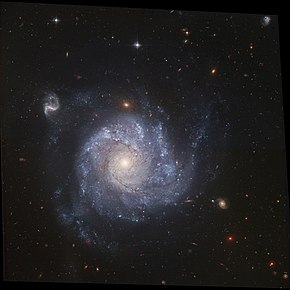
Summary
NGC 1309 is a spiral galaxy located approximately 120 million light-years away, appearing in the constellation Eridanus. It is about 75,000 light-years across, and is about 3/4s the width of the Milky Way. Its shape is classified as SA(s)bc, meaning that it has moderately wound spiral arms and no ring. Bright blue areas of star formation can be seen in the spiral arms, while the yellowish central nucleus contains older-population stars. NGC 1309 is one of over 200 members of the Eridanus Group of galaxies.[3]
| NGC 1309 | |
|---|---|
 Hubble Space Telescope (HST) image of NGC 1309 | |
| Observation data (J2000.0 epoch) | |
| Constellation | Eridanus |
| Right ascension | 03h 22m 06.5s [1] |
| Declination | −15° 24′ 00″ [1] |
| Redshift | 0.007125 (2136 +/- 4 km/s) [1] |
| Distance | 120 Mly (36 Mpc) [2] |
| Apparent magnitude (V) | 12.0 [1] |
| Characteristics | |
| Type | SA(s)bc [1] |
| Apparent size (V) | 2.2 x 2.0 arcmin[1] |
| Other designations | |
| PGC 012626 | |
Supernova 2002fk edit
SN 2002fk was discovered jointly by Reiki Kushida of the Yatsugatake South Base Observatory, Nagano Prefecture, Japan; and Jun-jie Wang and Yu-Lei Qiu of the Beijing Astronomical Observatory on Sept. 17.719 UT.[4] When it was discovered it was magnitude ~15.0; it was estimated to have reached maximum magnitude of ~13.0 before fading away. It was a Type Ia supernova (i.e., the progenitor star was white dwarf). White dwarfs are older stars that have used up almost all of their main fuel (the lighter elements such as hydrogen and helium). SN 2002fk's spectra showed no indications of hydrogen, helium or carbon; instead ionized calcium, silicon, iron and nickel were found.[5]
Supernova 2012Z edit
SN 2012Z was discovered jointly by S. B. Cenko, W. Li, and A. V. Filippenko using the Katzman Automatic Imaging Telescope on January 29.15 UT as part of the Lick Observatory Supernova Search.[7][8] The scientists have hypothesized that this is a type Iax supernova, and may have left behind a remnant zombie star. In February 2022 a study with new observations has confirmed that the star survived the explosion and is even brighter than before.[9][10]
References edit
- ^ a b c d e f "NASA/IPAC Extragalactic Database". Results for NGC 1309. Retrieved 8 Dec 2008.
- ^ Riess, Adam (Jul 2007). "The Final SHOE; Completing a Rich Cepheid Field in NGC 1309". Hubble Space Telescope Proposal ID #11329 (Cycle 16): 11329. Bibcode:2007hst..prop11329R.
- ^ "Hubble Snaps Images of a Pinwheel-Shaped Galaxy". News Release: STScI-2006-07. NASA. Retrieved 8 Dec 2008.
- ^ "International Astronomical Union Circular". Supernova 2002fk in NGC 1309. Central Bureau for Astronomical Telegrams.
- ^ Marion, G.H.; et al. (Jul 2003). "Near-Infrared Spectra of Type Ia Supernovae". The Astrophysical Journal. 591 (1): 316–333. arXiv:astro-ph/0306470. Bibcode:2003ApJ...591..316M. doi:10.1086/375290. S2CID 17925961.
- ^ "Supernova 2012Z in spiral galaxy NGC 1309, annotated". ESA/Hubble Press Release. Retrieved 8 August 2014.
- ^ "Electronic Telegram No. 3014". Central Bureau for Astronomical Telegrams. Retrieved 10 Apr 2021.
- ^ "Possible Supernova PSN J03220535-1523156 in NGC 1309 Narrowfield R - Jan 31". Flickr.com. Retrieved 4 Feb 2013.
- ^ "The Star that Survived a Supernova". lco.global. Retrieved 2022-06-22.
- ^ McCully, Curtis; Jha, Saurabh W.; Scalzo, Richard A.; Howell, D. Andrew; Foley, Ryan J.; Zeng, Yaotian; Liu, Zheng-Wei; Hosseinzadeh, Griffin; Bildsten, Lars; Riess, Adam G.; Kirshner, Robert P. (2022-02-01). "Still Brighter than Pre-explosion, SN 2012Z Did Not Disappear: Comparing Hubble Space Telescope Observations a Decade Apart". The Astrophysical Journal. 925 (2): 138. arXiv:2106.04602. Bibcode:2022ApJ...925..138M. doi:10.3847/1538-4357/ac3bbd. ISSN 0004-637X.
External links edit
- Media related to NGC 1309 at Wikimedia Commons


